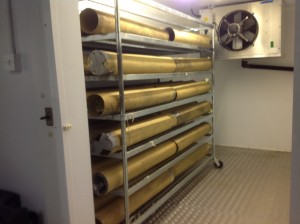I’m pleased to report that the ‘We Mak’em’ Sunderland Shipbuilding archives project is complete. The Sunderland shipyard records we held at the start of the project in June 2011 have all been catalogued. The nine shipyards covered by the project were:
- Austin & Pickersgill Ltd (including its predecessor S.P. Austin & Son Ltd)
- Bartram & Sons Ltd
- John Crown & Sons Ltd
- William Doxford & Sons Ltd
- Sir James Laing & Sons Ltd
- William Pickersgill & Sons Ltd
- Short Brothers Ltd
- J L Thompson & Sons Ltd
- North East Shipbuilders Ltd
All of these catalogues can now be searched from anywhere in the world through our online catalogue. Many thanks to the National Archives Cataloguing Grants Programme for the funding, which has enabled us to make these records available.
It was extremely satisfying to complete the project but no sooner had it finished than we received a major new donation of material for one of the firms, William Doxford & Sons Ltd. During the ‘We Mak’em’ project my colleague, Colin Boyd, catalogued a large quantity of Doxfords ships plans but we uncovered very few plans of the internationally acclaimed opposed piston diesel engines built by the firm. This was a real gap in the collection.
Following a donation last year of over 800 rolls of engineering plans from the Ballast Trust (based in Johnstone, near Glasgow) it’s fair to say that the gap has well and truly been filled. The new material includes around 300 rolls of plans relating to Doxford opposed piston engines. The donation also contains plans for a number of other major engineering firms including Parsons Marine Steam Turbine Company Ltd, Swan Hunter Ltd and Hawthorn Leslie Ltd. All these plans formed part of a much larger quantity of records transferred to the Ballast Trust back in 1991 by Kvaerner Kincaid Ltd.
This massive haul of plans was collected in the Tyne & Wear Archives & Museum lorry. Our driver, Barry Hannon, set off from Newcastle early on 24 October and reached Johnstone by mid morning. With help from the staff at the Ballast Trust, he loaded the engineering plans onto the DAF.
This was heroic stuff since he then had the long return journey to make back to Newcastle. The plans were unloaded the following morning with all Archives staff members helping out. It was a real team effort!
A large quantity of the plans was immediately loaded onto trolleys and taken to the Tyne & Wear Archives & Museums freezer. This is a large walk in blast freezer which, once turned on, drops the temperature down to minus 30 in about two and a half hours. The freezer is left running for 72 hours during which time any insects and their eggs and larvae will be killed. The process looks to eliminate pests such as booklice, silverfish, hide beetle, carpet beetle and clothes moth, which can cause significant damage to our collections.
Such vast deposits of records are rare but certainly not unheard of for the Archives. Indeed, the last time that we received a deposit on this scale was probably following the shipyard closures of the late 1980s. The sheer quantity of plans means that I am still at an early stage in sorting and arranging them.
It’s clear that the new material covers the development of the Doxford opposed piston engine from its beginnings in the early 1910s to it final days in the early 1980s. Work in sorting and cataloguing these plans will continue throughout 2013 and I’m sure that they will become a fantastic resource for those with an interest in the North East’s outstanding engineering heritage.
My thanks go to Dawn Bradshaw and Carolyn Ball who have both contributed to this blog. A big thank you also goes to the Ballast Trust for enabling us to bring these important engineering plans back home to the North East.




3 Responses to Bringing the North East’s engineering heritage back home